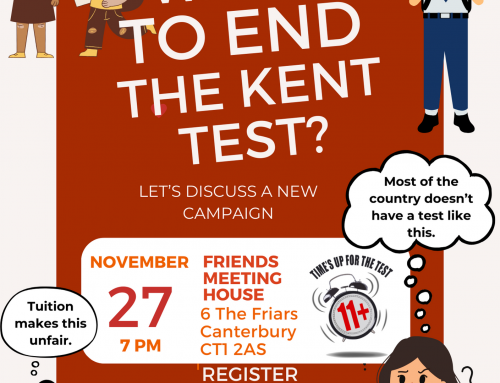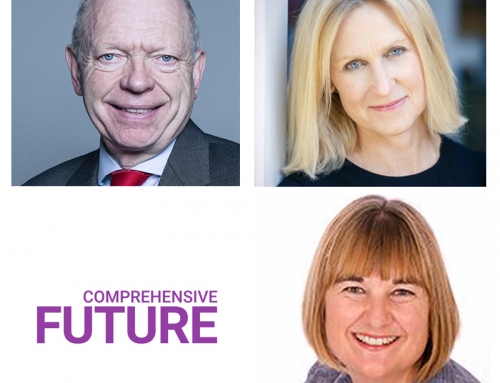1. A myth widespread in the press on which the case for keeping selection is based is that comprehensive education has failed. As Professor Peter Mortimore wrote recently ‘ I have been appalled by the frequency with which obviously untrue comments about comprehensive education have been disseminated by commentators and repeatedly parroted by politicians and the media. For those, like me, who have taught in a secondary modern as well as in the comprehensive school, the benefits of a system designed for all pupils are obvious’(i).
2. There is no doubt that since comprehensive education was largely introduced across the country there has been a huge rise in attainment. In 1953-54 10.7% of the relevant age group passed five or more GCE O levels at schools in England and Wales. In 1950 17,300 students were awarded first degrees and 2,400 were awarded higher degrees at UK universities. In 2015 56.1% of pupils achieved 5+ A*-C including English and maths in England. In 2013/14 there were 352,655 first degree qualifiers in England (ii).
3. When comprehensive students go to university there is evidence that they do better than those privately educated with the same entry qualifications. Dr Vidal Rodeiro, from Cambridge Assessment, the department of the University of Cambridge said: “In both Russell and non-Russell Group universities, students from independent schools were less likely to achieve either a first class degree or at least an upper second class degree than students from comprehensive schools with similar prior attainment (iii).
4. Selective systems are based on the myth that ability is fixed at 10+ and children have to go to different schools as a result. Children develop at different rates. Children’s aptitudes, abilities or potential cannot be forecast reliably at age 11. Research leading to the tests used in the past was shown to be fraudulent based on falsified data (iv). Research on the transfer test in Northern Ireland (the Northern Ireland 11 plus) found it to be neither reliable nor fair. Researchers said that more than 30% of pupils who took the Transfer Test could be assigned the wrong grade (v). Testing was found to be related to past experience rather than future potential (vi).
5. Much brain research shows that development occurs in spurts and is subject to many influences. Current neuroscience research is showing that brains are far more plastic than previously thought and can change significantly over time so it is now even more apparent that the result of test at 11 is not a good guide to intelligence. A key finding of the Royal Society Brainwaves project is that Changes in the brain’s structure and connectivity suggest there are sensitive periods in brain development extending beyond childhood into adolescence (vii).
6. Another study offers direct evidence that intelligence can change after early childhood Researchers from University College report that ‘our results emphasize the possibility that an individual’s intellectual capacity relative to their peers can decrease or increase in the teenage years. This would be encouraging to those whose intellectual potential may improve, and would be a warning that early achievers may not maintain their potential. Commenting on their research Professor Price said ‘”We have to be careful not to write off poorer performers at an early age when in fact their IQ may improve significantly given a few more years’(viii).
7. The Flynn effect has been identified, based on work by James Flynn’s findings that IQ has risen over generations, linked to environmental effects (ix).
8. Other myths, that there was a golden age when poor children went to grammar schools and achieved more as a result and that selective systems aid social mobility and that valid, reliable, specific tests which accurately identify a group who will benefit from grammar schooling are possible are dealt with elsewhere in Ending Selection the Evidence.
i Mortimore P,(2015) in Benn, M and Downs, J School Myths and the evidence that blows them apart. Routledge
ii DfE (2015) SFR37/2015: Provisional GCSE and equivalent results in England, 2014 to 2015. https://www.gov.uk/government/statistics/provisional-gcse-and-equivalent-results-in-england-2014-to-2015
Higher Education Statistics Agency and Department for Business, Innovation & Skills (2015) Higher education enrolments and qualifications obtained in the UK 2013 -2014
https://www.gov.uk/government/statistics/higher-education-enrolments-and-qualifications-obtained-in-the-uk-2013-to-2014
iii Rodiero and Zanini, (2015) The role of the A* grade at A level as a predictor of university performance in the United Kingdom Oxford Review of Education vol 41. issue 5 2015
iv Simon,B. (1985) Does Education Matter, Lawrence and Wishart; Chitty, C. (2007) Eugenics, Race and Intelligence in Education, Continuum.
v Gardner,J and Cowan,P, (2000) Testing the Test Queens University Belfast
vi Whetton C,(1995) Verbal Reasoning tests. In T.Husen & N Postlethwaite (Eds) International encyclopaedia of education (pp. 526-528) Oxford: Pergamon Press.
vii Brain Waves Module 2. (2011) Neuroscience implications for education and lifelong learning, The Royal Society.
viii Price,C et al (2011) Verbal and non-verbal intelligence changes in the teenage brain, Nature
ix Flynn, J (2012) Are we getting smarter. Cambridge University Press.




